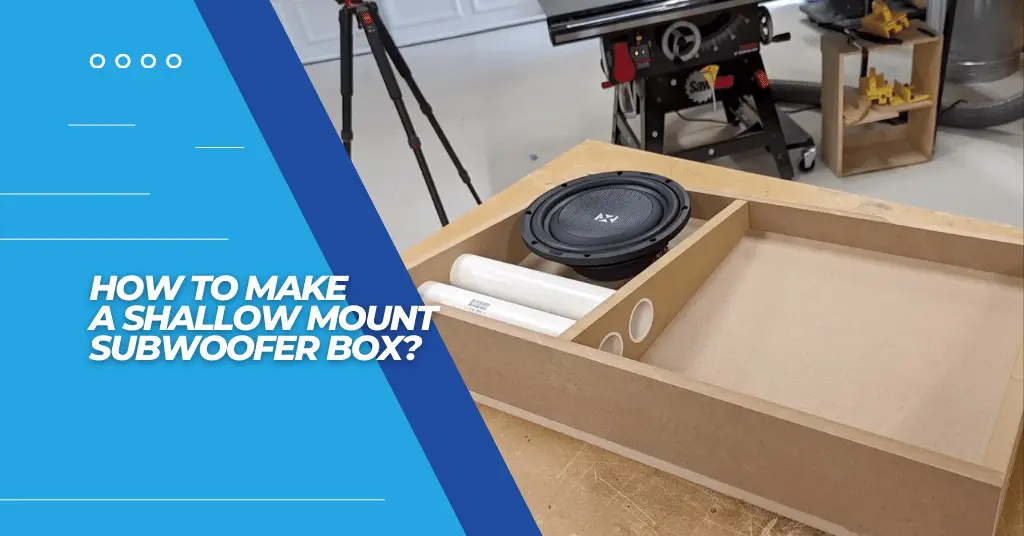How to Make a Shallow Mount Subwoofer Box?

If you want to add more bass to your car audio system without taking up too much space, then a shallow-mount subwoofer is the perfect solution.
Shallow mount subwoofers are designed to fit into tight spaces and provide plenty of low-end punch. Sometimes, you need to build yourself a shallow-mount subwoofer box for many reasons.
Making your own shallow-mount subwoofer box can be done with some essential tools, supplies, and a bit of know-how. In today’s article, I’ll help you make a shallow enclosure with some easy steps. So, let’s begin!
Which Enclosure Type Is Suitable for Your Shallow-Mount Sub: Ported or Sealed?
Choosing between a ported or sealed enclosure for your shallow-mount subwoofer requires careful consideration. Let me tell you the characteristics of each enclosure type:
Ported (Vented) Subwoofer Box:
- As by the name, ported boxes have a tuned hole or vent that allows the air to flow in and out of the enclosures, enhancing the bass response.
- Ported enclosures will always provide a deeper bass response than sealed boxes because the port allows the bass frequencies to move freely.
- Ported enclosures are more efficient as they allow subwoofers to produce more sound output with less power.
- However, ported subwoofers are always larger in size compared to sealed ones. That’s the reason space-conscious people more commonly use sealed enclosures.
- If I talk about the music genres, ported enclosures are more suitable for rock or electronic music.
Sealed Subwoofer Box:
- Sealed enclosures don’t have any ports or vents, making the subs produce tight and accurate bass sounds.
- These boxes are smaller in size, making them an ideal choice for trucks or vehicles with limited space.
- As mentioned above, sealed subwoofers can produce a more controlled and precise bass, but they may have less low-end extension or volume than ported boxes.
If you have decided on a shallow-mount subwoofer, I suggest you make a sealed enclosure. Those who use shallow-mount subwoofers have less space to place them. Therefore, the sealed enclosure will be an ideal choice for you.
How to Build a Shallow Mount Subwoofer Box?
Have you already decided which enclosure type is best for your shallow mount subwoofer, between sealed or ported? Let’s begin with the helpful guide!
1. Gather the Required Materials:
Before you begin, ensure you have the following materials to avoid any disruption while the building process:
- 3/4 inch medium-density fiberboard (MDF) or plywood
- Subwoofer speaker
- Speaker wire
- Terminal cup
- Screws
- Wood glue
- Speaker grill (optional)
- Carpet or vinyl covering material
- Electric drill
- Jigsaw
- Non-hardening rope caulk
2. Measure the Dimensions:
You need to measure the dimensions first. Refer to the specifications from your subwoofer’s manufacturer and pay attention to two critical factors: mounting depth and overall dimensions.
Ensure you follow the manufacturer’s instructions when measuring so your box is appropriately sized for your subwoofer. Measure several times before cutting any material to ensure accuracy and avoid waste of time and material.
Be sure to consider any obstacles like brackets or protrusions, too, so they don’t interfere with a proper fit of the box.
3. Calculate the Internal Volume:
You need to use an online subwoofer box calculator or software program to calculate the internal volume of a shallow-mount subwoofer box.
All you need to do is input the desired frequency response and dimensions of the box, and the calculator will provide you with the required internal volume for your subwoofer.
4. Design the Box:
Now, it is time to design the shallow mount subwoofer box based on the calculated internal volume. This includes sketching a design that adheres to the maximum dimensions determined earlier and noting down panel sizes and speaker cutout dimensions.
Once you have done this, it will be easier to build your shallow-mount subwoofer box accurately and quickly. It may take some time, but getting it right will save you plenty of time later.
5. Cut the Panels:
You must transfer your design measurements onto MDF or plywood sheets to cut the panels for a shallow-mount subwoofer box.
You can use a circular saw, jigsaw, or table saw to make the cuts accurately and label each panel clearly so that it does not get mixed up with other materials.
Remember to wear safety gloves and goggles when cutting out pieces and ensure all tools properly function before beginning work.
6. Determine the Subwoofer Diameter:
Look at the measurements printed on the measurements to measure the shallow mount subwoofer diameter accurately. The measurement you need is typically labeled “Cutout Diameter” or “Mounting Diameter”.
If no measurements are given, then use a ruler to measure from one side of the speaker frame to the other. Make sure to measure both horizontally and vertically for an accurate reading.
7. Cut the Speaker Hole:
To cut the speaker hole for a shallow mount subwoofer box, you’ll need to measure and mark where the hole should be on your panel.
Use a jigsaw or router to cut out this hole according to those measurements precisely. Make sure you take your time when cutting the speaker hole so that it fits snuggly against your subwoofer once mounted in the box.
However, the cutout diameter is at the center of the panel.
8. Assemble the Box:
Start by attaching the front, back, and side panels together with wood glue and screws. Secure each panel tightly so the box will hold together firmly.
Reinforce the joint corners with extra screws for added strength and stability. Ensure all the panels are aligned correctly to ensure your box is level and square when completed.
Assemble one piece at a time or carefully assemble in sections to reduce mistakes while building your shallow mounting subwoofer box.
Finish it off by adding screw hooks to attach it inside your car cabin or trunk space securely. After assembling the box, ensure you let the glue dry for at least four hours.
9. Install the Shallow Mount Speaker:
Now, it’s time to drop the shallow-mount subwoofer in the enclosure. Gently put the subwoofer inside the box. After insertion, don’t forget to tightly screw the subwoofer speaker so that it won’t come out or make any distorted noise when playing heavy bass music.
10. Install the Terminal Cup:
It is time to install the terminal cup. Mark and cut a hole for the terminal cup on one of the side panels. Securely attach the terminal cup with screws to ensure it is securely fastened.
Connect the speaker wires from your subwoofer to their corresponding terminals on the terminal cup. Finally, secure each wire in place; this will help protect against shorts and ensure long-term use without electrical issues or buzzing speakers.
11. Seal the Box:
To seal the shallow mount enclosure:
- Apply a wood glue or silicon sealant along the interior joints of the box where the panels meet.
- Ensure you get an even application from corner to corner, and use a small brush or putty knife to spread it out properly.
- Let it dry completely before testing your subwoofer. Once sealed, you’ll enjoy increased sound quality in your audio setup for years.
12. Cover the Box:
Now you can cover it with carpet or vinyl material to give it a more finished and stylish look. Depending on the preferences, adhesive or staples could secure the covering material to the box.
Doing so will help protect it from potential damage and improve its overall aesthetics. Additionally, you can use adhesive acoustic foam panels for added protection and sound dampening effect.
13. Attach the Speaker Grill (Optional):
Begin by finding the screws that come with the speaker grill itself. Place them in their respective holes and screw them into place to secure the grill firmly to the front panel of your box.
Ensure all screws are tightened adequately so that there is no risk of accidental damage to your subwoofer.
General FAQs
Do Shallow Mount Subs Sound Different?
Shallow mount subs can sound different than other subs depending on the sub’s size, shape, and placement. They offer less bass than deeper mounting options due to their space limitation, which can impact sound quality.
Can You Use Shallow Mount Subwoofer in a Ported Box?
Yes, shallow-mount subwoofers can be used in a ported box. However, the enclosure size must be much larger than conventional subwoofers, as a shallower driver requires more air volume inside the box to create a good bass response. The port will further increase the overall size of the box needed for optimal performance.
Can I Use a Shallow Mount Subwoofer in a Custom-Designed Box?
Yes, you can use a shallow-mount subwoofer in a custom-designed box. Shallow mount subwoofers are designed to fit into tight spaces due to their thinner shape and smaller size than conventional subs, allowing for more flexibility when planning the design of your sound system.
